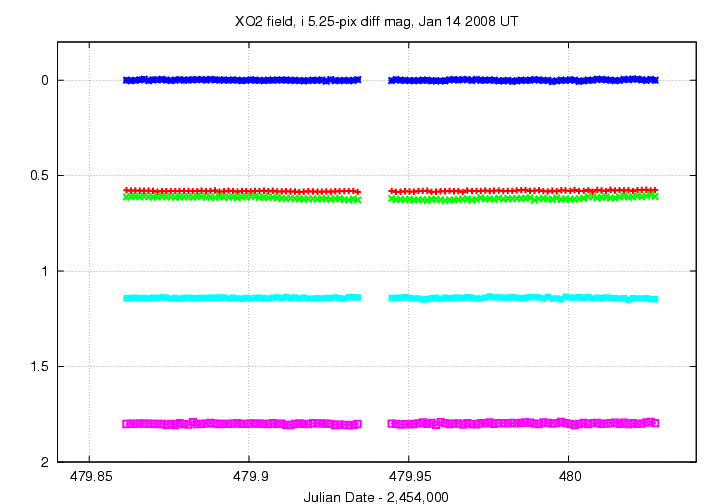
On the night of UT Jan 14, 2008, the SDSS Photometric Telescope ("PT" for short) took a series of exposures of XO-2. We detected ingress and egress under very good conditions.
Notes from the night
This is a chart of the field. XO-2 is the bright star indicated by the crosshairs. The labelled stars will appear in later analysis.

The host star of XO-2 has a magnitude V=11.18 according to XO-2b: Transiting Hot Jupiter in a Metal-rich Common Proper Motion Binary.
Following the procedures outlined by Kent Honeycutt's article on inhomogeneous ensemble photometry, I used all stars available in each image to define a reference frame, and measured each star against this frame. You can find the software package used to do the ensemble photometry online; it's free!
The night was clear. The graph below shows the amount by which instrumental magnitudes from each image needed to be shifted to match the ensemble reference. On a clear night, this graph would show a straight horizontal line.

Below is a graph of the scatter in differential magnitude versus magnitude in the ensemble solution.

XO-2 is the star at differential mag 0.61; it shows a small excess of scatter over neighboring stars of the same brightness. The "noise floor" in these measurements is about 0.003 mag -- about as good as I've seen for APO transit work.
Below are the light curves for the target (green symbols) and four comparison stars in the field.

In this closeup, I have shifted the data for two comparison stars to move them closer in magnitude to the target.

The transit in the green symbols is easy to see, despite the small gap in the middle.
An ephemeris grabbed from transitsearch.org predicts for this night
----------------------------------------------------------------------------------------
Begin Transit Window PREDICTED CENTRAL TRANSIT End Transit Window
All Times UT
HJD Year M D H M
2454479.90 2008 1 14 9 40 2454479.96 2008 1 14 11 3 2454480.02 2008 1 14 12 25
----------------------------------------------------------------------------------------
The ephemeris ingress of UT 2008 Jan 14 09:40:00 corresponds to JD 2,454,479.903, compared to my rough guess of 479.905. The ephemeris egress of UT 2008 Jan 14 12:25:00 corresponds to JD 2,454,480.018, compared to my guess of of 480.010 (the egress is not well defined, due to increased scatter). In short, the agreement between prediction and observation is good.
You can grab the measurements for your own analysis. Below is a table with three flavors of time, plus the differential magnitude of the target and an estimate of the uncertainty in each measurement. I show the first few lines of the file to give you an idea of its format.
# Measurements of XO-2 made with APO PT, Jan 14, 2008 UT. # Each exposure 50 seconds long in SDSS i-band; # Tabulated times are midexposure (FITS header time - half exposure length) # and accurate only to +/- 1 second (??). # 'mag' is a differential magnitude based on ensemble photometry # using a circular aperture of radius 5.25 arcseconds. # # UT day JD-2,450,000 HJD-2,450,000 mag uncert Jan14.86163 4479.86163 4479.86661 0.612 0.003 Jan14.86301 4479.86301 4479.86799 0.610 0.003 Jan14.86439 4479.86439 4479.86937 0.608 0.003
Last modified 01/30/2008 by MWR.